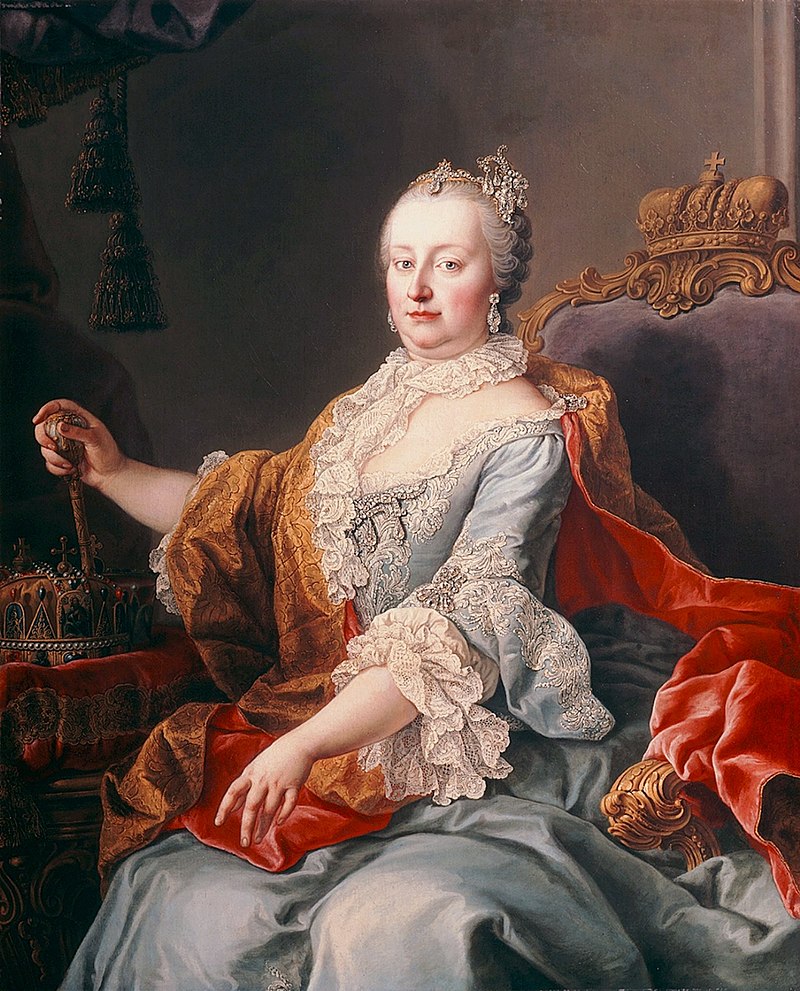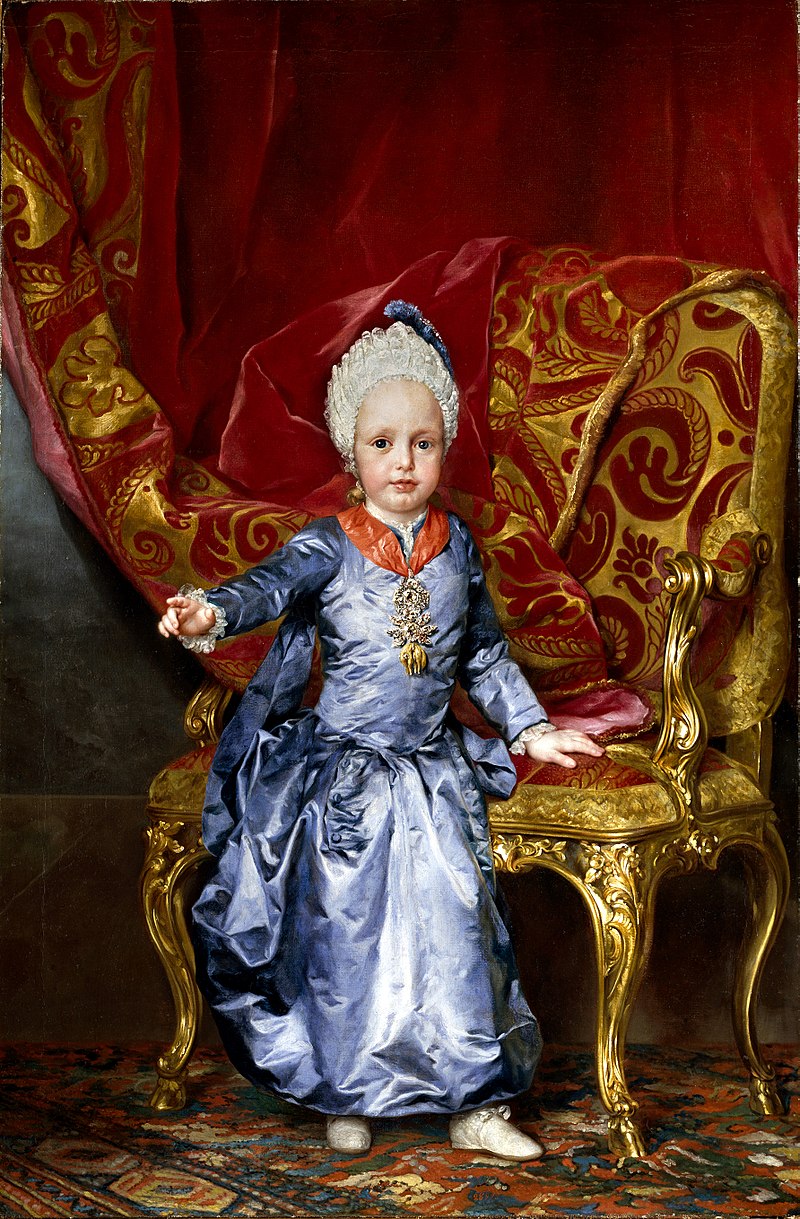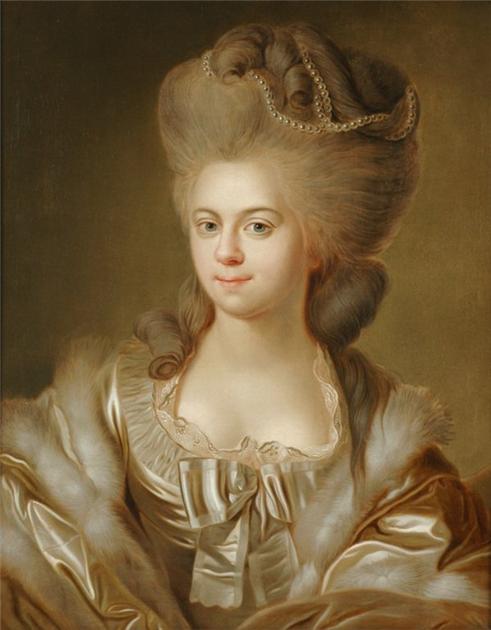by Susan Flantzer
© Unofficial Royalty 2016

Franz I, Emperor of Austria; Credit – Wikipedia
One day in February 1768, Maria Theresa, Archduchess of Austria and Queen of Hungary, Croatia, and Bohemia in her own right, rushed into the court theater at the Hofburg Palace in Vienna shouting, “Our Leopold has a boy!”, announcing the birth of her grandson, the future Franz II, Holy Roman Emperor who would later be Franz I, Emperor of Austria.
Maria Theresa had been the only surviving child of her father Holy Roman Emperor Karl VI. Throughout his reign, Charles expected to have a male heir and never really prepared Maria Theresa for her future role as sovereign. When her father died in 1740, Maria Theresa became Queen of Hungary, Croatia, and Bohemia in her own right. She was unable to become the sovereign of the Holy Roman Empire because she was female. Maria Theresa’s right to succeed her father was the cause of the eight-year-long War of the Austrian Succession.
The Habsburgs had been elected Holy Roman Emperors since 1438, but in 1742 Holy Roman Emperor Karl VII from the German House of Wittelsbach was elected. He died in 1745 and via a treaty, Maria Theresa arranged for her husband Francis Stephen, Duke of Lorraine to be elected Holy Roman Emperor. Despite the snub, Maria Theresa wielded the real power. Upon the death of her husband, Maria Theresa’s eldest son Joseph was elected Holy Roman Emperor Joseph II, but Maria Theresa continued to wield the real power. Joseph had married twice, but both wives died of smallpox. His first marriage had produced two daughters, one died at age seven and the other died shortly after birth. Maria Theresa’s Leopold was her second surviving son, and therefore the heir and the birth of his son ensured the succession of the throne.
The Holy Roman Empire was a limited elective monarchy composed of hundreds of kingdoms, principalities, duchies, counties, prince-bishoprics, and Free Imperial Cities in central Europe. The Holy Roman Empire was not really holy since, after Holy Roman Emperor Charles V in 1530, no emperors were crowned by the pope or a bishop. It was not Roman but rather German because it was mainly in the regions of present-day Germany and Austria. It was an empire in name only – the territories it covered were mostly independent each with its own ruler. The Holy Roman Emperor directly ruled over only his family territories, and could not issue decrees and rule autonomously over the Holy Roman Empire. A Holy Roman Emperor was only as strong as his army and alliances, including marriage alliances, made him. His power was severely restricted by the many sovereigns of the constituent monarchies of the Holy Roman Empire. From the 13th century, prince-electors, or electors for short, elected the Holy Roman Emperor from among the sovereigns of the constituent states.
Frequently but not always, it was common practice to elect the deceased Holy Roman Emperor’s heir. The Holy Roman Empire was an elective monarchy. No person had a legal right to the succession simply because he was related to the current Holy Roman Emperor. However, the Holy Roman Emperor could and often did, while still alive, have a relative (usually a son) elected to succeed him after his death. This elected heir apparent used the title King of the Romans.
Learn more at Unofficial Royalty: What was the Holy Roman Empire?
*********************

Franz’s grandmother Maria Theresa, Archduchess of Austria, Queen of Hungary, Croatia, and Bohemia; Credit – Wikipedia
Franz Joseph Karl was born on February 12, 1768, in Florence, the capital of Tuscany, now in Italy, where his father reigned as Grand Duke from 1765–90. Franz was the eldest son and the second of the sixteen children of Pietro Leopoldo I, Grand Duke of Tuscany (later Leopold II, Holy Roman Emperor) and Infanta Maria Luisa of Spain, the daughter of King Carlos III of Spain. Franz’s paternal grandparents were the formidable and powerful Empress Maria Theresa, who was in her own right Archduchess of Austria, Queen of Hungary, Queen of Croatia, and Queen of Bohemia, and Francis Stephen, Holy Roman Emperor, Grand Duke of Tuscany, and Duke of Lorraine. Even though her husband was the nominal Holy Roman Emperor, Maria Theresa wielded the real power. Franz’s maternal grandparents were Carlos III, King of Spain and Maria Amalia of Saxony.

Franz at the age of 2, 1770, by Anton Raphael Mengs; Credit – Wikipedia
Franz had fifteen siblings:
- Archduchess Maria Theresa (1767 – 1827), married Anton I, King of Saxony; no surviving issue.
- Ferdinand III, Grand Duke of Tuscany (1769 – 1824), married (1) Princess Luisa of Naples and Sicily; had issue; (2) Princess Maria Ferdinanda of Saxony; no issue
- Archduchess Maria Anna (1770 – 1809), unmarried, Abbess at the Theresian Convent in Prague
- Archduke Charles (1771 – 1847), married Henrietta of Nassau-Weilburg; had issue
- Archduke Alexander Leopold (1772 – 1795), unmarried, accidentally burned to death during a fireworks show
- Archduke Albrecht Johann Joseph (1773 – 1774), died in infancy
- Archduke Maximilian Johann Joseph, (1774 – 1778), died in early childhood
- Archduke Joseph (1776 – 1847), married (1) Grand Duchess Alexandra Pavlovna of Russia; no surviving issue; (2) Princess Hermine of Anhalt-Bernburg-Schaumburg-Hoym; had issue; (3) Duchess Maria Dorothea of Württemberg; had issue.
- Archduchess Maria Clementina of Austria (1777 – 1801) – married the future King Francesco I of the Two Sicilies, had issue
- Archduke Anton Victor (1779 – 1835), unmarried, became Grand Master of Teutonic Knights
- Archduchess Maria Amalia (1780 – 1798), unmarried
- Archduke Johann (1782 – 1859), married morganatically Countess Anna Plochl; had issue
- Archduke Rainer (1783 – 1853), married Princess Elisabeth of Savoy; had issue.
- Archduke Louis (1784 – 1864), unmarried
- Archduke Rudolph (1788 – 1831), unmarried, became Archbishop of Olomouc (in the present-day Czech Republic) and a Cardinal

Franz with his parents and siblings, circa 1784-1785; Credit – Wikipedia
Franz had a happy childhood surrounded by his numerous siblings in Florence. His father Leopold was active in his children’s upbringing and encouraged freedom and self-expression. His children were encouraged to run about freely and participate in energetic play. Archduchess Maria Christina, the children’s paternal aunt, recalled with delight being rolled on the floor with her nieces and nephews. The children’s education was a hands-on one. The British ambassador Sir Horace Mann was impressed with Franz’s education: “He played at Geography by the dissected maps that I was desired to get from England, and on all his walks and rides he is accompanied by people who amuse him and instruct him. He has learned the principal modern languages as the natives do, having attendants of different nations who always speak their own language to him, by which means, they are familiar to him.” This pleasant life ended for Franz in 1784 when he was 16 years old. His uncle, Holy Roman Emperor Joseph II, summoned him to the imperial court in Vienna to be prepared as a future emperor.
Soon after he arrived in Vienna, Franz received a memo from his uncle listing his deficiencies: “physical development has been completely neglected,” “stunted in growth,” “very backward in bodily dexterity,” “a spoiled mother’s boy.” Joseph told Franz that if he did not improve methods involving “fear and unpleasantness” would be used. Franz learned to control his feelings and the expression of his opinions based on his uncle’s demands. He was sent to join a military regiment in Hungary to complete his education.

Elisabeth of Württemberg, Archduchess of Austria; Credit – Wikipedia
A bride was chosen for Franz by the Emperor. Duchess Elisabeth of Württemberg, daughter of Friedrich II Eugen, Duke of Württemberg and Friederike of Brandenburg-Schwedt, was chosen for political reasons and sent to Vienna in 1762 when she was 15-years old. Brought up as a Lutheran, Elisabeth was educated at the Monastery of the Salesian Sisters in Vienna, where she converted to Roman Catholicism. Franz and Elisabeth were married on January 6, 1788. On February 18, 1790, Elisabeth gave birth to a premature daughter Archduchess Ludovika Elisabeth of Austria, and then she died early on the morning of February 19, 1790, at the age of 22. The next day, on February 20, 1790, Holy Roman Emperor Joseph II died at the age of 49. The infant Archduchess did not survive long, dying on June 24, 1791. Within a week of his 22nd birthday, Franz became a widower and the heir to the throne, which now passed to his father, Holy Roman Emperor Leopold II. Franz’s father’s reign was only two years and at age 24, he became Franz II, Holy Roman Emperor.

Maria Theresa of Naples and Sicily; Credit – Wikipedia
Franz married again, a little more than six months after the death of his first wife. On September 15, 1790, Franz married Maria Theresa of Naples and Sicily, the eldest daughter of King Ferdinand IV and III of Naples and Sicily (later King Ferdinand I of the Two Sicilies) and Archduchess Marie Caroline of Austria. Franz and Maria Theresa were double first cousins, which meant they had the same two sets of grandparents. The couple had twelve children but only seven survived childhood. While pregnant with her twelfth child, Maria Theresa fell ill with the lung infection pleurisy. Her doctor bled her and this caused premature labor. Maria Theresa gave birth to her twelfth child who lived only three days. On April 13, 1807, a week after giving birth, Maria Theresa died at the age of 34. Franz was inconsolable and had to be forcibly removed from his wife’s body.
Franz and Maria Theresa’s children:
- Archduchess Marie-Louise (1791 – 1847), married (1) Napoleon Bonaparte; had issue (2) Adam Albert, Count von Neipperg; had issue (3) Charles, Count of Bombelle, no issue
- Emperor Ferdinand I (1793 – 1875), married Maria Anna of Savoy; no issue
- Archduchess Marie Caroline (1794 – 1795), died in childhood
- Archduchess Caroline Ludovika (1795 – 1797), died in childhood
- Archduchess Maria Leopoldina (1797 – 1826), married Pedro I, Emperor of Brazil, had issue
- Archduchess Maria Clementina (1798 – 1881), married her maternal uncle Leopold, Prince of Salerno, had issue
- Archduke Joseph Franz Leopold (1799 – 1807), died in childhood, no issue
- Archduchess Marie Caroline (1801 – 1832), married Crown Prince (later King) Frederick Augustus II of Saxony, no issue
- Archduke Franz Karl (1802 – 1878), married Princess Sophie of Bavaria; had issue including Franz Joseph I, Emperor of Austria and Maximilian, Archduke of Austria, Emperor of Mexico
- Archduchess Maria Anna (1804 – 1858), unmarried, intellectually disabled like her eldest brother, Emperor Ferdinand I
- Archduke Johann Nepomuk (1805 – 1809), died in childhood
- Archduchess Amalie Theresa (born and died 1807), died in childhood

Franz, Maria Theresa, and their children; Credit – Wikipedia
Austria took part in the French Revolutionary Wars, lasting from 1792 until 1802, resulting from the French Revolution, which saw the rise of an unknown French general named Napoleon Bonaparte. During the Napoleonic Wars of the early 19th century, Holy Roman Emperor Franz II feared that Napoleon could take over the personal, hereditary Habsburg lands within the Holy Roman Empire, so in 1804 he proclaimed himself Emperor Franz I of Austria. After Napoleon’s victory at the Battle of Austerlitz, in 1806, the Holy Roman Empire was dissolved. The lands of the Holy Roman Empire were given to Napoleon’s allies, creating the Kingdom of Bavaria, the Kingdom of Württemberg, and the Grand Duchy of Baden. In 1809, Franz attacked France again but was again defeated. This time, Franz was forced to ally himself with Napoleon, ceding territory to the French Empire, and marrying his daughter Marie-Louise to Emperor Napoleon. In 1813, for the final time, Austria turned against France and joined Great Britain, Russia, Prussia, and Sweden in their war against Napoleon. Austria played a major role in the final defeat of France, and Emperor Franz I of Austria, represented by Clemens von Metternich, presided over the Congress of Vienna held in Vienna from September 1814 to June 1815. The objective of the Congress was to provide a long-term peace plan for Europe by settling critical issues arising from the French Revolutionary Wars and the Napoleonic Wars.

Napoleon meets Franz following the Battle of Austerlitz; Credit – Wikipedia
Franz married two more times. On January 6, 1808, he married another first cousin, Maria Ludovika of Austria-Este, the daughter of Archduke Ferdinand of Austria-Este and Maria Beatrice Ricciarda d’Este. Maria Ludovika was a great enemy of Napoleon and protested the marriage of her stepdaughter Marie-Louise to Napoleon. Franz and Maria Ludovika had no children, and Maria Ludovika died on April 7, 1816, of tuberculosis at the age of 28.

Maria Ludovika of Austria-Este; Credit – Wikipedia
Franz’s fourth and last wife was Princess Caroline Augusta of Bavaria, daughter of Maximilian I Joseph, King of Bavaria and Augusta Wilhelmine of Hesse-Darmstadt. The couple married on October 29, 1816, but had no children.

Caroline Augusta of Bavaria; Credit – Wikipedia
On March 2, 1835, the day after the 43rd anniversary of his father’s death, Franz died suddenly of a fever at the age of 67. For three days, the people of Vienna filed past his coffin. His coffin was then brought in the traditional procession to the Capuchin Church (German: Kapuzinerkirche) in Vienna, Austria, where the Imperial Crypt (German: Kaisergruft), the traditional burial place of the Habsburgs, lies underneath the rather plain church. Franz’s remains lie in the Franzensgruft (Franz’s Vault) surrounded by the tombs of his four wives.

Tomb of Holy Roman Emperor Franz II/Emperor Franz I of Austria; Photo Credit – Susan Flantzer
This article is the intellectual property of Unofficial Royalty and is NOT TO BE COPIED, EDITED, OR POSTED IN ANY FORM ON ANOTHER WEBSITE under any circumstances. It is permissible to use a link that directs to Unofficial Royalty.
Austria Resources at Unofficial Royalty
